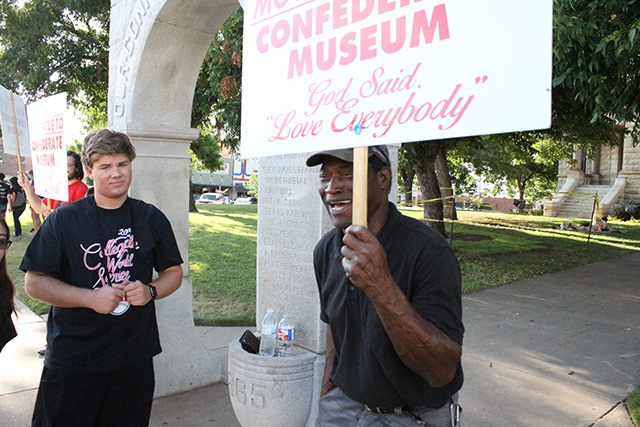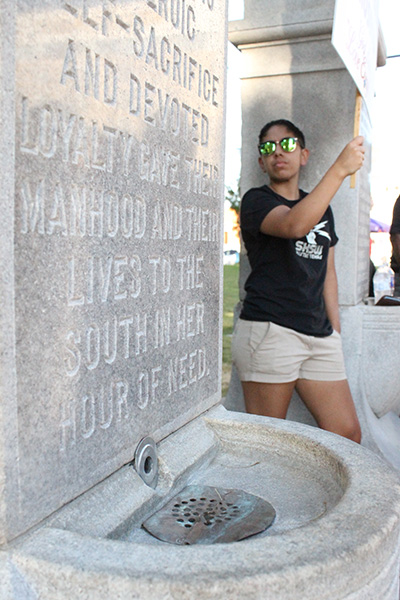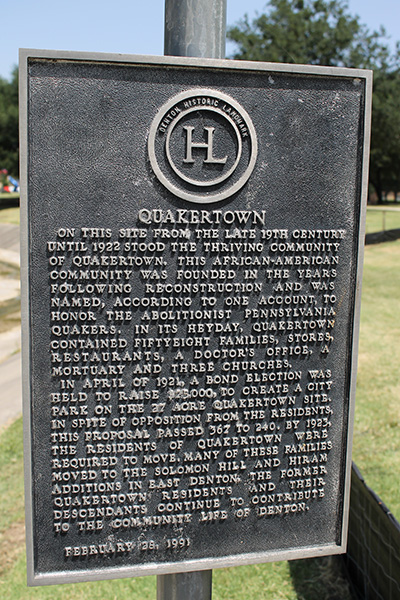
Local civil rights leader Willie Hudspeth has faced down adversarial county judges and commissioners, irate bystanders — even assault rifles — throughout his more than 16-year campaign to remove a prominent monument to fallen Confederate soldiers in his northern Texas town of Denton.
Hudspeth, who serves as president of Denton’s local chapter of the NAACP, has called, off and on since 1999, for the large statue in front of Denton County’s historic Courthouse on the Square to be removed. He has been joined in his efforts recently by student groups and other organizations working for racial justice — and by similar campaigns scrutinizing Confederate symbols across Texas and the U.S.
“I didn’t have any help in the beginning. No one was going down [to the County Commissioner’s Court] with me, so I just thought I would have to shut [the campaign] down for a while,” Hudspeth told Truthout from his local resale shop in Denton.
Hudspeth said he found renewed support for the statue’s removal in the aftermath of the racist massacre in June of nine worshippers by a white gunman at the historic Emanuel AME church in Charleston, South Carolina, and the subsequent removal of the Confederate battle flag from the state’s capitol grounds.

Following a wave of vandalizations of Confederate monuments and statues across the nation since the Charleston massacre, a masked pair spray painted the words “THIS IS RACIST” across the Denton monument last month, reigniting the debate about the monument, its history and what it means to the city’s Black residents.
“Never in my wildest dreams did I think there was going to be this much support — never, ever thought it. But there is, and now we’re moving ahead,” Hudspeth said.
Denton’s Confederate monument is one of thousands of similar Confederate memorials located on state and county courthouse grounds throughout the nation. It was erected in 1918 by a local chapter of the United Daughters of the Confederacy and is arguably not simply a reminder of the soldiers who died fighting in the Civil War.
The two drinking fountains at the base of the monument’s pillars — which Hudspeth and other longtime Denton residents allege were formerly “whites only” fountains — tellingly construe a historical memorial to fallen soldiers and the subsequent, post-Reconstruction Jim Crow era. The Jim Crow laws enforced a racial caste system that still permeates U.S. society today in the form of mass incarceration and daily police violence perpetrated against people of color, alongside other forms of institutional racism.
Hudspeth has petitioned the Denton County Commissioner’s Court for more than a decade to either have the monument removed and placed in a Confederate museum, or to have the statue restored and its drinking fountains made functional once more so that, as he says, “everyone can take a drink.”
But Hudspeth’s struggle to bring down Denton’s 1918 Confederate monument is only one of the battles over such monuments heating up in the state of Texas and across the South.
Confederate Battles Rage in Texas
Only two weeks after Denton’s monument was vandalized, a Dallas statue of the commander of the Confederate Army of Virginia during the Civil War, Robert E. Lee, was spray painted with the word “SHAME.”
After a statue of the Confederate leader Jefferson Davis at the University of Texas (UT) campus in Austin was similarly vandalized, University President Gregory Fenves announced in June the creation of a 12-member task force of students and faculty charged with providing a list of recommendations for the fate of such Confederate symbols on campus for Fenves to review. The task force is expected to hand their recommendations over to Fenves August 10.
Among the options the task force is considering is moving the statues to the Dolph Briscoe Center for American History in Austin, according to Gregory Vincent, who is chairing the task force and who serves as UT’s vice president for diversity and community engagement. He told Truthout that removing and/or moving the statues to a museum is overwhelmingly supported by the student body.
“There are some themes that have been developed…. One is respecting donor intent, … the second theme is that we are an education institution, and we want to be sure that we respectfully and accurately reflect history,” Vincent told Truthout. “Then finally, we are strongly committed to creating and nurturing an inclusive learning and working community for everyone on campus.”
In July, five Democratic state legislators wrote a letter to Gov. Greg Abbott asking for the creation of a similar task force that would consider the appropriateness of the numerous Confederate monuments on Texas capitol grounds.
But even as calls to remove markers of the Confederacy grow across the state, Confederate ancestral groups are intent on erecting more. The Sons of Confederate Veterans are planning to fly 32 Confederate flags along the interstate connecting Louisiana to Orange, Texas, as well as construct an obelisk for 450 Confederate soldiers in an Austin cemetery.
Hudspeth’s struggle against his own local symbol of the Confederacy in Denton underscores a bureaucratic unwillingness to face the harsh realities that such symbols and markers of the Confederacy are synonymous with the legacy of chattel slavery in the South.
Even after Hudspeth followed all the proper procedures and filed the necessary applications to have the monument restored and its fountains made operational with the approval of the Texas Historical Commission and the city of Denton, Hudspeth says his ultimate hurdle has been the approval of the Denton County Commissioner’s Court and County Judge Mary Horn.
“Instead of [the Commissioner’s Court] being honest with me and telling me, straight-up, the truth about [the process to apply for the monument’s restoration], they kept lying to me, and covering it up, covering it up, covering it up,” Hudspeth says. “They had me chasing rabbits.”
Chasing the White Rabbit of a Whitewashed History

Hudspeth first approached the Denton County Commissioner’s Court to have the statue placed in the museum inside Denton County Courthouse on the Square in 1999. After talking to a longtime friend who disagreed with Hudspeth’s approach to the monument, he decided to change his strategy and push for the monument’s restoration (including making its fountains operational) in 2000.
Throughout that year, Hudspeth worked to put together a team of professionals in the fields of restoration, construction, architecture and plumbing who supported his efforts to restore water to the monument, many of whom offered their services to him for free. Hudspeth worked to raise the remaining money that county representatives said was needed to do the job.
He then sent an application to request the monument’s restoration, called an antiquities permit, to the Historical Commission. Since the monument is designated as a Texas Historic Landmark, the Commission must approve any and all alterations (including restorative efforts) made to it. Hudspeth saved all documentation of his communications between the Denton County Commissioner’s Court and the Historical Commission and allowed Truthout to review his files.
The Historical Commission initially rejected Hudspeth’s antiquities permit, citing the need for additional documentation of the work proposed and the signature of the Denton County representative approving the request. According to Hudspeth’s documents, Denton County Judge Mary Horn signed off on the antiquities permit in 2002, and the Historical Commission accepted the proposal for restoration, outlining several specifications for the process, in August that year.
After Hudspeth’s permit was granted, he said county representatives told him the city would not approve making the fountains functional because there was not an existing water line to the monument, and that it would be too expensive to run a line out to the fountains. Hudspeth went to the city about the problem, and they signed off on his request to run a water line to the monument as well as his restoration expert’s drainage solution.
Ultimately, Hudspeth says, it was Denton County Judge Horn who simply rejected restoring the monument, but she contends that the fountains were never operational in the first place and that it was the Historical Commission who rejected restoring the fountains because the monument would have to be disassembled to do so. According to the Denton Record-Chronicle, the Denton County Office of History and Culture has no record of a water line ever connecting to the monument’s fountains.
A Historical Commission spokesperson confimed to Truthout that their office did approve a permit for restoration work on the monument in 2002, but that no completion report was ever submitted to the Commission, telling Truthout that the holdup rests with Denton County.
“I’ve had people tell me, ‘Oh, I remember drinking out of those when I was a child.’ No you don’t. They never worked. You drank out of a fountain on the lawn perhaps, but it wasn’t [at the monument],” Judge Horn told Truthout.
She maintained that position this week during a Denton County Commissioner’s Court meeting in which Denton resident Shirley Mann testified that she remembers avoiding the monument’s fountains as a Black child growing up in the ’40s in Denton. She told Judge Horn she avoided the fountains because they weren’t labeled “colored” and she thought she’d be punished if she did.

“As Black kids, we knew that there were only certain fountains that we could drink out of — the one that said ‘colored’ and so, therefore, I was not allowed to drink from the fountain out by the statue or the other fountains that were treated as ‘white,'” Mann told Judge Horn Tuesday. “All I know is there was a fountain under the statue there. There was water, the birds drank out of it, I guess the white folks too, I don’t know, because I didn’t fool with that fountain because I couldn’t get into any trouble.”
Another longtime Black Denton resident backed up Mann’s account of the fountains, telling Truthout that she remembers the fountains working but not well, because they had a very low water pressure. She told Truthout she also avoided the fountains, instead opting to use the bathrooms in the basement of the Denton County Courthouse on the Square for a quarter.
“We didn’t worry about those fountains,” said Betty Kimble, who directs Denton’s American Legions senior center. “We knew what we could do and what we couldn’t do, and we didn’t worry about it.”

In addition to residents who say they remember the fountains working, a preservationist wrote to former County Judge Scott Army in 2002, stating that the Historical Commission neglected to restore a missing light fixture at the top of the monument because there was no evidence to support its initial existence and that the agency didn’t want to create “a false sense of history.” The same letter states that missing components of the fountains would be replicated but not made functional — not because they weren’t functional previously — but because they did not comply with the Americans with Disabilities Act.
“It’s a memorial to the soldiers who fought in the Civil War,” Judge Horn told Truthout. “I’m old enough to remember the Vietnam War. I have classmates that died in Vietnam, and certainly there were a lot of people that protested that war, and we’ve had a memorial in Washington, D.C., for those soldiers, and I certainly wouldn’t want that memorial taken down either.”
In 2010, the Denton County Commissioner’s Court considered and approved a plaque with language claiming the monument as “a testimony that God created all men equal” in response to Hudspeth’s concerns about the monument.

But now, bolstered by the national debate regarding Confederate symbols after the Charleston massacre, Hudspeth is again intent on having the statue placed in the museum inside the historic Denton County Courthouse on the Square, because regardless of whether the fountains worked or not, it’s clear that Black Denton residents avoided them, he said.
For Hudspeth, the monument is a reminder of how slavery has affected his own family. His great great grandfather was held as a slave, and Hudspeth said he was purposely bred to be muscular. “The other memories that [the monument] conjures up really bugs me: hanging my people, beating them dead,” he said.
A study by the Equal Justice Initiative released this year found white people in the South lynched close to 4,000 Black men, women and children between 1877 and 1950 — a sum including at least 700 more lynchings of Black people than previously documented. The report counted 376 lynchings in Texas alone, with two occurring in Denton County.

Historically, white people in the city of Denton were responsible for the mass eviction of the historically well-known Black community at Quakertown. The community served as the business and residential center for nearly 60 Black families by 1920, creating a safe haven for freed and former slaves in the post-Reconstruction 1860s. But the president of the expanding Industrial College of Arts, now Texas Woman’s University, viewed Quakertown as an obstacle to the school’s accreditation. The Denton Chamber of Commerce, with the support of the Denton Club for Women and City Leaders, petitioned for a bond election in January of 1921 to fund the mass eviction of Quakertown residents so that a park system could be put in Quakertown’s place. In April of that year, the initiative succeeded by 127 votes.
“When they moved Quakertown, they put the sign at Quakertown. I didn’t go over there and look at it because I said, ‘Give the people the money that you owe them for uprooting them and putting them over there into nothing,'” Hudspeth told Truthout, referring to the Black community’s relocation to Denton’s Solomon Hill.
For now, Hudspeth says he is committed to continuing his organizing efforts and getting the issue of the monument put back onto the Denton County Commissioner’s Court agenda.
Help us Prepare for Trump’s Day One
Trump is busy getting ready for Day One of his presidency – but so is Truthout.
Trump has made it no secret that he is planning a demolition-style attack on both specific communities and democracy as a whole, beginning on his first day in office. With over 25 executive orders and directives queued up for January 20, he’s promised to “launch the largest deportation program in American history,” roll back anti-discrimination protections for transgender students, and implement a “drill, drill, drill” approach to ramp up oil and gas extraction.
Organizations like Truthout are also being threatened by legislation like HR 9495, the “nonprofit killer bill” that would allow the Treasury Secretary to declare any nonprofit a “terrorist-supporting organization” and strip its tax-exempt status without due process. Progressive media like Truthout that has courageously focused on reporting on Israel’s genocide in Gaza are in the bill’s crosshairs.
As journalists, we have a responsibility to look at hard realities and communicate them to you. We hope that you, like us, can use this information to prepare for what’s to come.
And if you feel uncertain about what to do in the face of a second Trump administration, we invite you to be an indispensable part of Truthout’s preparations.
In addition to covering the widespread onslaught of draconian policy, we’re shoring up our resources for what might come next for progressive media: bad-faith lawsuits from far-right ghouls, legislation that seeks to strip us of our ability to receive tax-deductible donations, and further throttling of our reach on social media platforms owned by Trump’s sycophants.
We’re preparing right now for Trump’s Day One: building a brave coalition of movement media; reaching out to the activists, academics, and thinkers we trust to shine a light on the inner workings of authoritarianism; and planning to use journalism as a tool to equip movements to protect the people, lands, and principles most vulnerable to Trump’s destruction.
We’re asking all of our readers to start a monthly donation or make a one-time donation – as a commitment to stand with us on day one of Trump’s presidency, and every day after that, as we produce journalism that combats authoritarianism, censorship, injustice, and misinformation. You’re an essential part of our future – please join the movement by making a tax-deductible donation today.
If you have the means to make a substantial gift, please dig deep during this critical time!
With gratitude and resolve,
Maya, Negin, Saima, and Ziggy